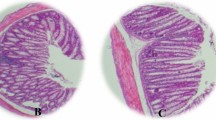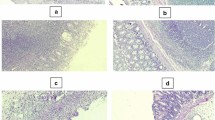Abstract
Ulcerative Colitis (UC) is an inflammatory bowel disorder that affects colon and rectum. Treatments in many UC patients remain variably effective and are associated with considerable adverse effects. So the present study was undertaken to explore the antiinflammatory effects of emu oil, glycyrrhizin, and combination of emu oil and glycyrrhizin in acetic acid-induced UC in rats. UC was induced by intracolonic instillation of 5 % acetic acid in rats. Emu oil and glycyrrhizin were orally administered to test groups. Severity of colitis was scored macroscopically and microscopically. The levels of myeloperoxidase and antioxidant enzymes namely catalase, superoxide dismutase and glutathione peroxidase were assessed spectrophotometrically. Expressions of PPARγ and TNFα were studied by real-time PCR. Acetic acid caused severe damage to colon and rectum. Emu oil and glycyrrhizin were found to significantly reduce macroscopic and microscopic lesions and decrease levels of myeloperoxidase. There was a significant improvement of antioxidant levels in treatment groups compared to acetic acid group. Combination of emu oil and glycyrrhizin showed a markedly greater modulation of PPARγ and TNFα expression than emu oil and glycyrrhizin when administered alone. Combination of emu oil and glycyrrhizin might have had synergistic effects in regulating PPARγ and TNFα. Further studies on mechanism of action of emu oil and glycyrrhizin combination would pave the way to define possibility of this combination as effective in the management of UC.








Similar content being viewed by others
References
Abimosleh SM, Tran CD, Howarth GS (2013) Emu oil reduces small intestinal inflammation in the absence of clinical improvement in a rat model of indomethacin-induced enteropathy. Evid Based Complement Altern Med 2013:1–10
Appleyard CB, Wallace JL (1995) Reactivation of hapten-induced colitis and its prevention by anti-inflammatory drugs. Am J Physiol 269:G119–G125
Bennett DC, Code WE, Godin DV (2008) Comparison of the antioxidant properties of emu oil with other avian oils. Aust J Exp Agric 48:1345–1350
Buffinton GD, Doe WF (1995) Depleted mucosal antioxidant defences in inflammatory bowel disease. Free Radic Biol Med 19:911–918
Calder PC (2006) n-3 Polyunsaturated fatty acids, inflammation, and inflammatory diseases. Am J Clin Nutr 83:1505S–1519S
Claiborne A (1985) Catalase activity. In: Greenwald RA (ed) CRC handbook of methods in oxygen radical research. CRC Press, Boca Raton, pp 283–284
Conner EM, Brand SJ, Davis JM, Kang DY, Grisham MB (1996) Role of reactive metabolites of oxygen and nitrogen in inflammatory bowel disease: toxins, mediators, and modulators of gene expression. Inflamm Bowel Dis 2:133–147
Dubuquoy L (2003) Impaired expression of peroxisome proliferator-activated receptor gamma in ulcerative colitis. Gastroenterology 124:1265–1276
Eckl PM (2003) Genotoxicity of HNE. Mol Aspects Med 24:161–165
Faria FM, Luiz-Ferreira A, Socca EAR, Almeida ACA, Dunder RJ, Manzo LP et al (2012) Effects of Rhizophora mangle on experimental colitis induced by TNBS in rats. Evid Based Complement Altern Med 2012:1–11
Forman HJ, Zhang H, Rinna A (2009) Glutathione: overview of its protective roles, measurement, and biosynthesis. Mol Aspects Med 30:1–12
Iseri SO, Ersoy Y, Ercan F, Yuksel M, Atukeren P, Gumustas K, Alican I (2009) The effect of sildenafil, a phosphodiesterase-5 inhibitor, on acetic acid-induced colonic inflammation in the rat. J Gasterol Hepatol 24:1142–1148
Kase Y, Saitoh K, Ishige A, Komatsu Y (1998) Mechanisms by which Hange-shashin-to reduce prostaglandin E2 levels. Biol Pharm Bull 21:1277–1281
Kaser A, Zeissig S, Blumberg RS (2010) Inflammatory bowel disease. Annu Rev Immunol 28:573–621
Krawisz JE, Sharon P, Stenson WF (1984) Quantitative assay for acute intestinal inflammation based on myeloperoxidase activity: assessment of inflammation in rat and hamster models. Gastroenterology 87:1344–1350
Lindsay RJ, Geier MS, Yazbeck R (2010) Orally administered emu oil decreases acute inflammation and alters selected small intestinal parameters in a rat model of mucositis. Br J Nutr 104:513–519
Marklund S, Marklund G (1974) Involvement of the superoxide anion radical in the autooxidation of pyrogallol and a convenient assay for superoxide dismutase. Eur J Biochem 47:469–474
Morris GP, Beck PL, Herridge MS, Depew WT, Szewczuk MR, Wallace JL (1989) Hapten-induced model of chronic inflammation and ulceration in the rat colon. Gastroenterology 96:795–803
Pavlick KP, Laroux FS, Fuseler J, Wolf RE, Gray L, Hoffmann J et al (2002) Role of reactive metabolites of oxygen and nitrogen in inflammatory bowel disease. Free Radical Biol Med 33:311–322
Pawar SH, Shete RV, Patil BM, Pattankude VS, Otari KV, Kore KJ (2010) Effect of glycyrrhizin, ammonium salt in experimental animal models of inflammatory bowel disease. Int J Pharm Life Sci 1:479–491
Rotruck JT, Pope AL, Ganther HE, Swanson AB, Hageman DG, Hoekstra WG (1973) Selenium: biochemical role as a component of glutathione peroxidise. Science 179:588–590
Schmittgen TD, Livak KJ (2008) Analyzing real-time PCR data by the comparative CT method. Nat Protoc 3:1101–1108
Sharon P, Stenson WF (1985) Metabolism of arachidonic acid in acetic acid colitis in rats similarity to human inflammatory bowel disease. Gastroenterology 88:55–63
Snowden JM, Whitehouse MW (1997) Anti-inflammatory activity of emu oils in rats. Inflammopharmacology 5:127–132
Tran DC, Katsikeros R, Abimosleh SM (2012) Current and novel treatments for ulcerative colitis. In: Shennak MM (ed) Ulcerative colitis from genetics to complications. Intech Publishers, Croatia, pp 190–210
Usmar DVM, Severn A (1991) Treatment of macrophages with oxidized low-density lipoprotein increases their intracellular glutathione content. Biochem J 278:429–434
Wahli W, Michalik L (2012) PPARs at the crossroads of lipid signaling and inflammation. Trends Endocrin Met 23:351–363
Whitehouse MW, Turner AG, Davis CK, Roberts MS (1998) Emu oil(s). A source of non-toxic transdermal anti-inflammatory agents in aboriginal medicine. Inflammopharmacology 6:1–8
Witaicenis A, Luchini AC, Hiruma-Lima CA, Ferisbino SL, Garrido-Mesa N, Utrilla P et al (2012) Suppression of TNBS induced colitis in rats by 4-methyl esculetin, a natural coumarin: comparison with prednisolone and sulphasalazine. Chem Biol Interact 195:76–85
Acknowledgments
We thank the Dean, Madras Veterinary College and the Director of Research, Tamil Nadu Veterinary and Animal Sciences University for funding and providing infrastructure to carry out the research. We sincerely thank Dr. Daniel J. Chandran, Dr. John Kirubakaran and Dr. Gururaj, Department of Veterinary Microbiology, Madras Veterinary College, for providing guidance about real-time PCR studies. We are grateful to Dr. Tensing Gnanaraj for his continuous support on the study and greatly acknowledge the efforts of VR3 Emu farms and Hatchery Unit (Pondicherry) for providing Emu oil required for the study as gratis. We thank Dr. Hariharan (late) for his valuable support for the study. We acknowledge efforts of Dr. Ramesh for his support in the study. We also appreciate and thank Basker, Shriharsh, Chandramohan, Sumathi, Venkat, Baisakhi, Bhuvana, Venkatesan, and Uthrakumar for their inputs and help in conducting this study.
Conflict of interest
The authors declare that they have no competing interests.
Author information
Authors and Affiliations
Corresponding author
Rights and permissions
About this article
Cite this article
Sethuraman, S.N., Swaminathan, S., Nelson, S.B. et al. Modulation of PPARγ and TNFα by emu oil and glycyrrhizin in ulcerative colitis. Inflammopharmacol 23, 47–56 (2015). https://doi.org/10.1007/s10787-014-0226-8
Received:
Accepted:
Published:
Issue Date:
DOI: https://doi.org/10.1007/s10787-014-0226-8




